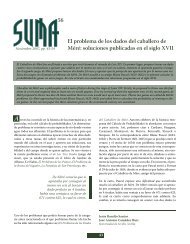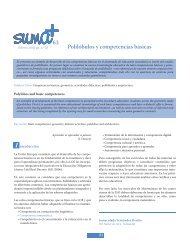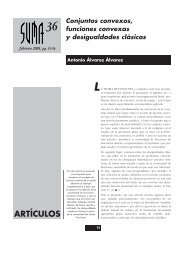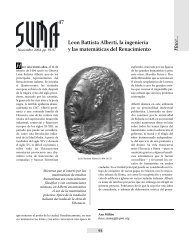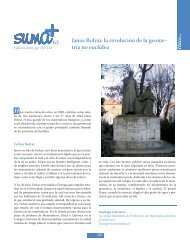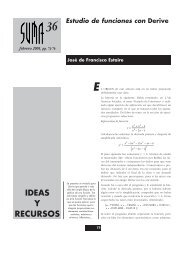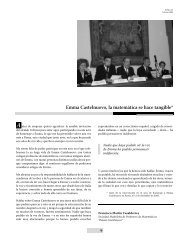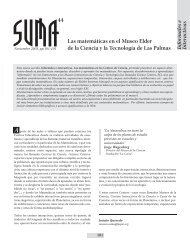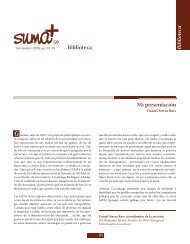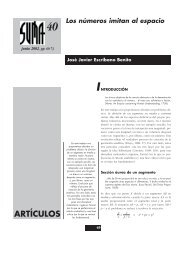Resolución de problemas mediante la regla de falsa posición: un ...
Resolución de problemas mediante la regla de falsa posición: un ...
Resolución de problemas mediante la regla de falsa posición: un ...
You also want an ePaper? Increase the reach of your titles
YUMPU automatically turns print PDFs into web optimized ePapers that Google loves.
SUMA 56<br />
Noviembre 2007<br />
El marco teórico<br />
En el presente trabajo se ha seguido <strong>un</strong> marco teórico basado<br />
en <strong>la</strong> revisión <strong>de</strong> documentos históricos. Así, se realiza <strong>un</strong><br />
estudio <strong>de</strong> <strong>la</strong> reg<strong>la</strong> <strong>de</strong> <strong>falsa</strong> <strong>posición</strong> a partir <strong>de</strong> diferentes textos,<br />
<strong>de</strong>s<strong>de</strong> el papiro <strong>de</strong> Rhind (1650 a. C.), don<strong>de</strong> <strong>la</strong> reg<strong>la</strong> citada<br />
era el método utilizado para resolver <strong>problemas</strong>, hasta textos<br />
<strong>de</strong>l siglo XIX (Tratado Elemental <strong>de</strong> Matemáticas <strong>de</strong> J. M.<br />
Vallejo) en el cual ya es consi<strong>de</strong>rado como <strong>un</strong> método eficaz<br />
<strong>de</strong> aproximación numérica <strong>de</strong> ecuaciones (no necesariamente<br />
lineales).<br />
Metodología<br />
Mo<strong>de</strong>lo <strong>de</strong> competencia formal<br />
¿Qué es <strong>la</strong> reg<strong>la</strong> <strong>de</strong> <strong>falsa</strong> <strong>posición</strong>?<br />
Se trata <strong>de</strong> <strong>un</strong> procedimiento aritmético que permite resolver<br />
ecuaciones lineales. Para ello parte <strong>de</strong> <strong>un</strong> valor cualquiera<br />
(método simple) o <strong>de</strong> dos valores (doble <strong>falsa</strong> <strong>posición</strong>). A<br />
partir <strong>de</strong> estas <strong>falsa</strong>s posiciones se obtiene <strong>la</strong> solución <strong>de</strong> <strong>la</strong><br />
ecuación por proporcionalidad.<br />
Ejemplo 1: Calcu<strong>la</strong> <strong>un</strong> número tal que ese número más su<br />
mitad sea 15.<br />
Para resolver el problema partimos <strong>de</strong> <strong>un</strong> número (<strong>posición</strong>)<br />
cualquiera. Sea 2 (puesto que <strong>de</strong> el<strong>la</strong> es sencillo calcu<strong>la</strong>r su<br />
mitad). El número, 2, más su mitad, 1, es 3, distinto <strong>de</strong> 15. Se<br />
trata <strong>de</strong> <strong>un</strong>a <strong>falsa</strong> <strong>posición</strong>. Para encontrar <strong>la</strong> <strong>posición</strong> verda<strong>de</strong>ra<br />
proce<strong>de</strong>mos por proporcionalidad:<br />
Luego, x = 10.<br />
Posición Solución<br />
2 3<br />
x 15<br />
2 3<br />
x 15<br />
<br />
Ejemplo 2: Hal<strong>la</strong> <strong>un</strong> número tal que cinco veces ese número<br />
menos 10 sea 0.<br />
Para resolver este problema por <strong>la</strong> reg<strong>la</strong> doble partimos <strong>de</strong> dos<br />
posiciones. Sean 3 y 4. Para 3: 5·3-10 = 5 y para 4: 5·4-10=10.<br />
Tenemos dos <strong>falsa</strong>s posiciones. Para obtener <strong>la</strong> solución calcu<strong>la</strong>mos:<br />
56<br />
que es <strong>la</strong> solución <strong>de</strong>l problema.<br />
Gráficamente:<br />
• Método simple:<br />
Ecuación: ax = b<br />
Falsa <strong>posición</strong>: ax0=e<br />
Solución:<br />
• Método <strong>de</strong> doble <strong>falsa</strong> <strong>posición</strong>:<br />
Por tratarse <strong>de</strong> <strong>un</strong>a re<strong>la</strong>ción <strong>de</strong> proporcionalidad <strong>la</strong> re<strong>la</strong>ción se<br />
pue<strong>de</strong> expresar <strong>de</strong> forma lineal:<br />
ax + b = 0<br />
Para nuestras dos aproximaciones:<br />
ax1 + b = e1<br />
ax2 + b = e2<br />
Restando ambas expresiones:<br />
10 354 x 2<br />
10 5<br />
xb<br />
x <br />
e<br />
0<br />
a(x1 - x2) = e1 - e2<br />
Multiplicando (1) por x2 y (2) por x1:<br />
(1)<br />
(2)<br />
ax1 x2 + bx2 = e1 x2<br />
ax2 x1 + bx1 = e2 x1<br />
y restando ambas expresiones obtenemos:<br />
b(x2 - x1) = e1 x2 - e2 x1<br />
Por último, dividiendo (4) entre (3):<br />
(3)<br />
(4)



